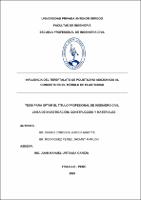Mostrar el registro sencillo del ítem
Influencia del tereftalato de polietileno adicionado al concreto en el módulo de elasticidad
| dc.contributor.advisor | Urteaga Garcia, Juan Manuel | |
| dc.contributor.author | Chero Cordova, Karen Janette | |
| dc.contributor.author | Rodriguez Perez, Jhomny Marlon | |
| dc.creator | Chero Cordova, Karen Janette | |
| dc.date.accessioned | 2021-03-24T17:24:07Z | |
| dc.date.available | 2021-03-24T17:24:07Z | |
| dc.date.issued | 2021 | |
| dc.identifier.uri | https://hdl.handle.net/20.500.12759/7307 | |
| dc.description.abstract | La presente investigación busca determinar en qué medida influye el PET adicionado en el módulo de elasticidad de concretos de 210 kg/cm2 , 280 kg/cm2 y 350 kg/cm2 con respecto a un concreto tradicional. Para esto se utilizaron agregados de la cantera “LEKERSA” ubicada en el centro poblado El Milagro, distrito de Huanchaco, Trujillo – La Libertad. Además, se utilizó el aditivo Chema Plast para reducir la relación agua/cemento. El cemento utilizado fue de la marca Inka Tipo ICo. Específicamente en nuestra investigación, hemos preparado 12 diseños de mezcla correspondientes a los distintos porcentajes de PET agregado y los diferentes f’c requeridos. Fijamos resistencias de 210kg/cm2 , 280 kg/cm2 y 350 kg/cm2 , donde se ejecutó 3 dosificaciones para concreto patrón y 3 adicionando el porcentaje de aditivo (5, 10 y 15%). Al realizar las mezclas se determinó las principales propiedades del concreto fresco, como son la trabajabilidad, homogeneidad, consistencia y densidad, para posteriormente tomar las muestras y curarlas correctamente. Todos los ensayos para concreto endurecido se realizaron a la edad de 28 días. Determinamos el módulo de elasticidad estático experimental del concreto para cada resistencia según lo especificado en la norma ASTM C- 469, y se calculó la formula el módulo de elasticidad teórico propuesta por el ACI 318-11, 8.5,1 y con respecto a la fórmula del reglamento nacional de edificaciones, E- 060 concreto armado y ACI 318 concluimos que las formulas representan lo mismo y haciendo la comparativa el M.E.E. Experimental varían en -11% a +6%. | es_PE |
| dc.description.abstract | The present investigation seeks to determine to what extent the added PET influences the modulus of elasticity of concrete of 210 kg / cm2, 280 kg / cm2 and 350 kg / cm2 with respect to traditional concrete. For this, aggregates from the “LEKERSA” quarry located in the El Milagro town center, Huanchaco district, Trujillo - La Libertad, were used. In addition, the Chema Plast additive was used to reduce the water / cement ratio. The cement used was of the Inka Type ICo brand. Specifically in our research, we have prepared 12 mix designs corresponding to the different percentages of added PET and the different f’c required. We set resistances of 210kg / cm2, 280 kg / cm2 and 350 kg / cm2, where 3 dosages for standard concrete were carried out and 3 adding the percentage of additive (5, 10 and 15%). When making the mixtures, the main properties of fresh concrete were determined, such as workability, homogeneity, consistency and density, to subsequently take the samples and cure them correctly. All tests for hardened concrete were performed at the age of 28 days. We determined the experimental static modulus of elasticity of concrete for each resistance as specified in ASTM C-469, and calculated the formula for the theoretical modulus of elasticity proposed by ACI 318-11, 8.5,1 and with respect to the formula of the national building regulations, E-060 reinforced concrete and ACI 318 we conclude that the formulas represent the same and making the comparison the MEE Experimental vary from -11% to + 6%. | en_US |
| dc.description.uri | Tesis | es_PE |
| dc.format | application/pdf | es_PE |
| dc.language.iso | spa | es_PE |
| dc.publisher | Universidad Privada Antenor Orrego | es_PE |
| dc.relation.ispartofseries | T_ING.CIVIL_1931 | |
| dc.rights | info:eu-repo/semantics/openAccess | es_PE |
| dc.rights.uri | https://creativecommons.org/licenses/by/4.0/ | es_PE |
| dc.source | Universidad Privada Antenor Orrego | es_PE |
| dc.source | Repositorio Institucional - UPAO | es_PE |
| dc.subject | Tereftalato de polietileno | es_PE |
| dc.subject | Concreto | es_PE |
| dc.subject | Módulo de elasticidad | es_PE |
| dc.title | Influencia del tereftalato de polietileno adicionado al concreto en el módulo de elasticidad | es_PE |
| dc.type | info:eu-repo/semantics/bachelorThesis | es_PE |
| thesis.degree.level | Titulo Profesional | es_PE |
| thesis.degree.grantor | Universidad Privada Antenor Orrego. Facultad de Ingeniería | es_PE |
| thesis.degree.name | Ingeniero Civil | es_PE |
| thesis.degree.discipline | Ingeniería Civil | es_PE |
| dc.subject.ocde | https://purl.org/pe-repo/ocde/ford#2.01.01 | es_PE |
| renati.advisor.orcid | https://orcid.org/0000-0001-5395-9432 | es_PE |
| renati.author.dni | 70004414 | |
| renati.author.dni | 70485418 | |
| renati.advisor.dni | 18181285 | |
| renati.type | https://purl.org/pe-repo/renati/type#tesis | es_PE |
| renati.level | https://purl.org/pe-repo/renati/nivel#tituloProfesional | es_PE |
| renati.discipline | 732016 | es_PE |
| renati.juror | Cancino Rodas, Cesar | |
| renati.juror | Vega Benites, Jorge | |
| renati.juror | Vertiz Malabrigo, Manuel | |
| dc.publisher.country | PE | es_PE |
Ficheros en el ítem
Este ítem aparece en la(s) siguiente(s) colección(es)
-
Ingeniería Civil [1149]


